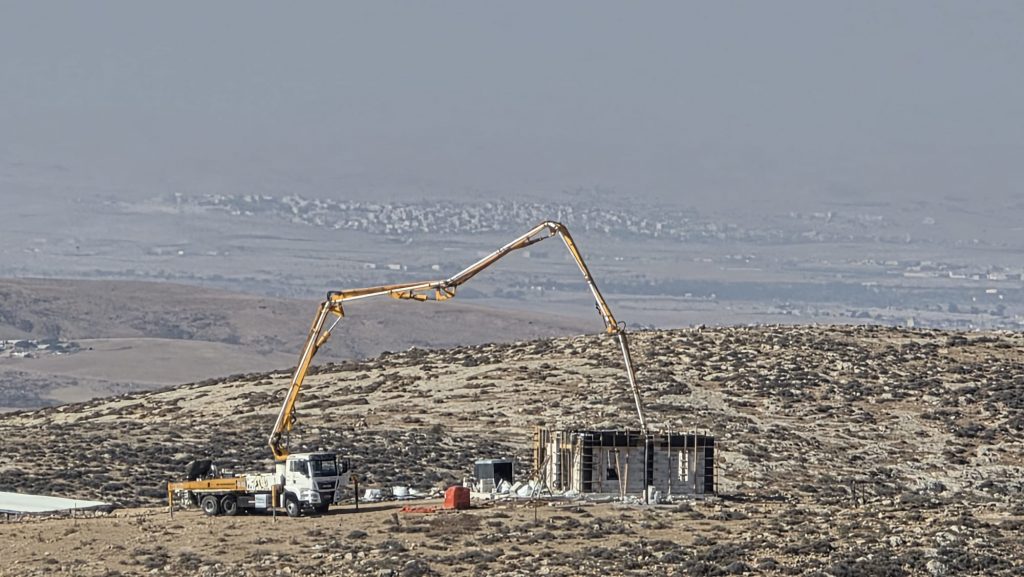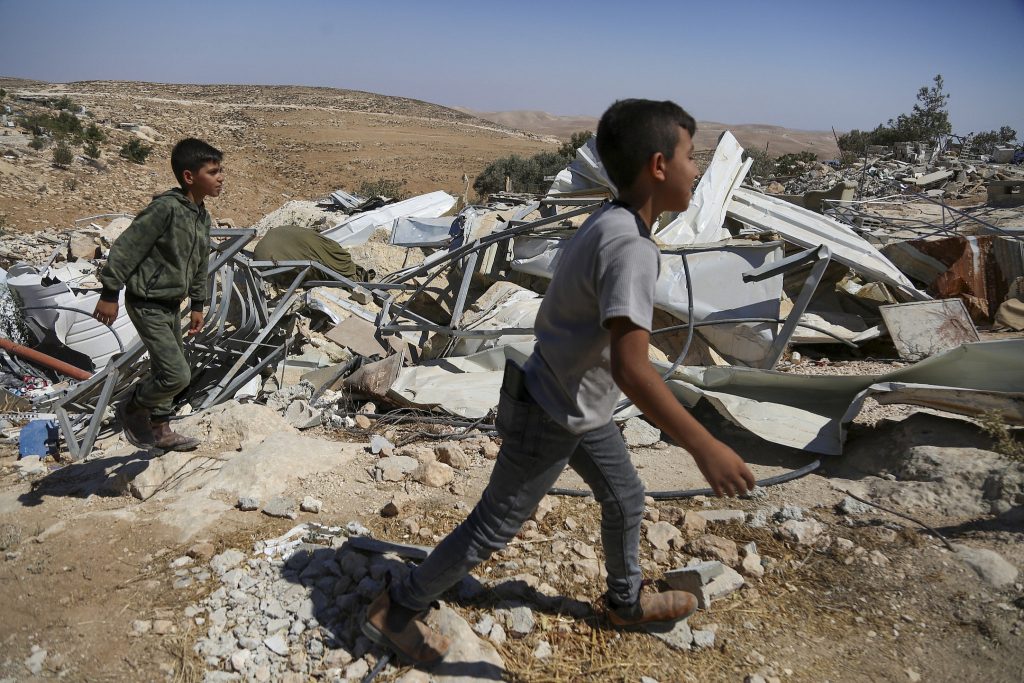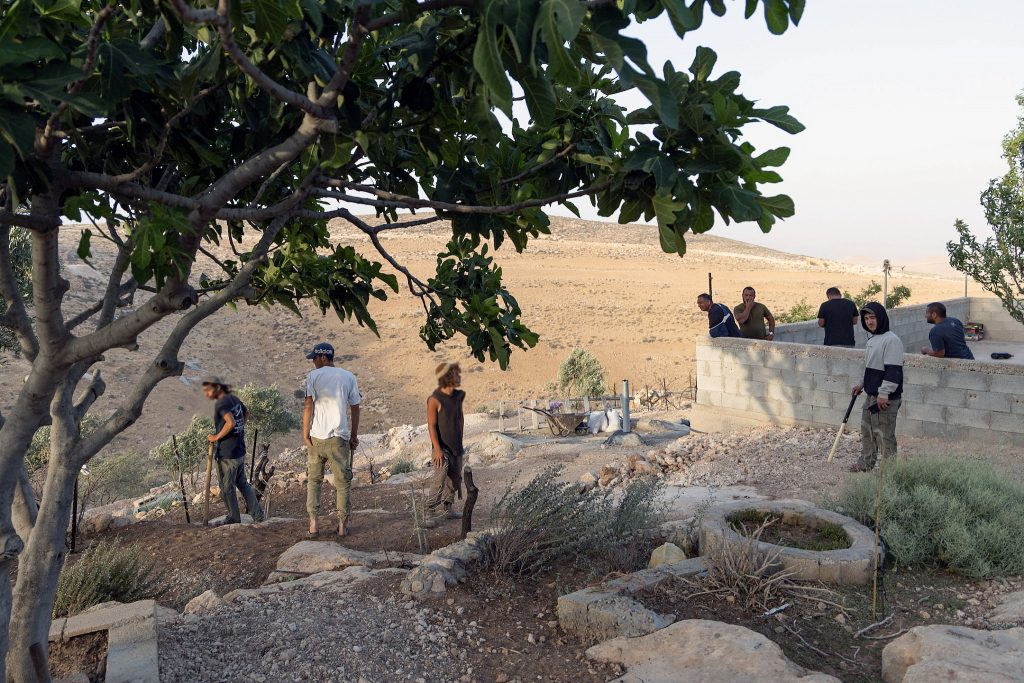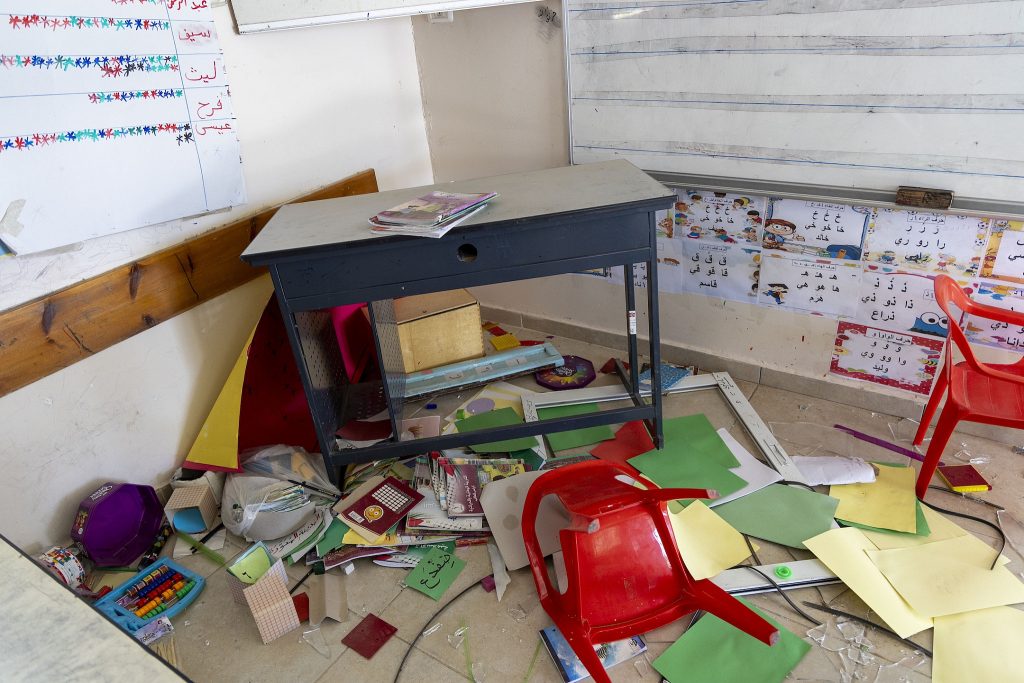While settlers’ concrete mixers rumble under the Israeli army’s watch, Palestinian life in Masafer Yatta is being dismantled piece by piece.
Ever since settlers from the Mitzpe Yair outpost first descended on the village of Tabaqat al-Jundi in Masafer Yatta in November 2021, Jamil Al-Amour’s family has endured relentless harassment and violent attacks.
That month, they shot and wounded Al-Amour’s son and another relative, and set fire to the family’s agricultural shed. They have returned repeatedly since then, often accompanied by Israeli soldiers, to demolish the rebuilt structure, uproot olive saplings, and graze their livestock on the family’s land. During this time, they also expanded the outpost they’ve been building on the village’s property; by 2024, it included a sheep pen, tents, solar panels, and several caravans.
Officially, the settlers are not permitted to be in this area. Tabaqat al-Jundi is one of 12 Palestinian communities located within what the Israeli army designates as “Firing Zone 918,” a military training zone officially closed to both Palestinians and Israelis. Yet while Palestinians are routinely barred from building or even entering the area, settlers continue to establish and expand outposts there with complete impunity.
In August 2025, settlers marked a new phase of their entrenchment in the firing zone. In broad daylight, they used concrete pumps and cement mixers to lay foundations for a permanent structure in Tabaqat al-Jundi. Despite the work being illegal even under Israeli law, they faced no interference from the army or police.
As settlers worked around the clock in Tabaqat al-Jundi, Israeli army bulldozers descended on the nearby village of Khalet al-Daba, which also lies within Firing Zone 918. Since May, Israeli forces have raided the village multiple times, reducing most of it to rubble. Today, no houses remain, and only a few makeshift tents offer residents scant protection from the coming winter.

In recent weeks, two Israeli army patrols – on Sept. 27 and Oct. 10 – targeted Khalet al-Daba’s remaining structures, demolishing a tent made of plastic sheets and stones, and forcing 60-year-old Su’ad Dababseh to destroy the few bricks he had salvaged from his demolished home. When he arranged them neatly, soldiers warned him: “‘Either destroy them yourself or we’ll arrest you,’” he recounted in a conversation with +972.
An Israeli army spokesperson stated in response to +972’s inquiry that “the construction elements mentioned in Khalet al-Daba were established within Firing Zone 918, which is closed to entry and movement, without any permit and in violation of the law.” The spokesperson added that Israeli forces “carried out several enforcement actions, in accordance with legal procedures and the approved enforcement priorities.”
The spokesperson did not specifically address +972’s questions regarding Israeli settler construction in Tabaqat al-Jundi.
A tried and true tool of dispossession
Although the army has occasionally ordered Palestinian communities to evacuate temporarily during military exercises in the firing zones, the impunity settlers enjoy inside Firing Zone 918 reinforces what residents of Masafer Yatta have long known: these zones were never really about military training, but about forcing Palestinians off their land to make way for Jewish settlement.
Firing Zone 918 was declared by the Israeli army in the early 1980s. By then, Israel had already designated large swaths of land in the occupied West Bank as closed military zones — officially off-limits to civilians who are not considered “permanent residents.” The state has since maintained that Palestinian communities in Firing Zone 918 live in “seasonal settlements” in order to justify their expulsion.

The real purpose of the firing zones was made explicit by the policy’s architect, then-Agriculture Minister Ariel Sharon. Speaking in a 1979 meeting of the World Zionist Organization’s Settlement Division, the former Israeli prime minister stated: “The firing zones were created for one purpose — land reserves for settlements.”
Since the first outposts were established in Firing Zone 918 in 1999, the 12 villages of Masafer Yatta that lie within the 3,000-hectare (approximately 30,000-dunam) area have faced an existential threat of displacement. Israel has carried out thousands of demolitions and confiscations targeting Palestinian families, while preventing them from connecting to water or electricity networks, paving roads, or even bringing vehicles into the area. In July 2022, a mobile Doctors Without Borders clinic that provided basic medical services had to close because Palestinians were barred from entering the area.
In recent years, settlers have steadily accelerated their entrenchment inside the firing zone. Between 1999 and 2024, they established 11 outposts — nine of them in just the past two years, including six since October 7, 2023.
Most of these outposts are clustered in the northern section of the zone. In July 2012 the army reclassified much of this area as an “inactive firing zone.” Human rights group Breaking the Silence has pointed out the move conveniently protects three of the earliest and largest outposts — Havat Ma’on, Avigail, and Mitzpe Yair — parts of which extend into the firing zone. By declaring that section “inactive,” the army effectively legitimized the outposts, shielding them from legal challenges and paving the way for the expulsion of eight Palestinian villages located in the remaining “active” area of the zone.
Human rights lawyer Netta Amar-Shiff explained that “the differentiation between the zones is kind of informal, and they keep it in a gray area. For [Jewish] outpost purposes, the distinction exists. For Palestinians, it doesn’t.” In practice, when Palestinians appeal demolition orders or apply for building permits, the army makes no distinction between “active” and “inactive” firing zones — both are treated as grounds for demolition, and permit requests are routinely denied.

This double standard — in which Palestinian construction is deemed to obstruct army training while settler outposts expand freely — is not unique to Firing Zone 918. According to settler-watchdog Kerem Navot, the same pattern has spread across the West Bank over the past decade. It is now evident in Firing Zone 203 west of Ramallah and Firing Zone 934 nearby.
The prototype, the group notes, is Firing Zone 904A near Nablus, east of the villages of Aqraba and Beit Furik, which settlers have gradually taken over entirely since the late 1990s. At the current pace, a similar fate awaits the Palestinians who still live in Firing Zone 918.
Impunity on full display
As in Tabaqat al-Jundi, the construction of the illegal outpost in Al-Halaweh — where settlers have already taken control of nearly all private land, according to the Masafer Yatta Council — has been accompanied by a sharp rise in violence. “This outpost has become a nightmare for residents of surrounding villages,” Nidal Abu Younis, head of the council, told +972. “Settlers routinely attack residents and schoolchildren who pass through.”
On Aug. 28, settlers and soldiers from the outpost stormed the home of 50-year-old Ragheb Hoshiya in the neighboring village of Al-Mirkez, smashing his sons’ phones and iPad, and destroying furniture. Before leaving, they drew water from the family’s well to use for their sheep and camels. “Our suffering has become unbearable with these settlers living so close,” Hoshiya lamented.
At the end of June, settlers brought their sheep to graze on land belonging to families from Al-Mirkez. When residents tried to drive the livestock away, settlers claimed they had been attacked — prompting soldiers from a nearby base to arrive and arrest around 16 people, including women and children. Since then, settlers have been bringing their herds daily to graze on residents’ olive groves and farmland. Terrified of theft and attack, many no longer dare to let out their sheep.
According to Abu Younis, the Masafer Yatta Council filed a legal complaint in May 2025 over ongoing settler attacks originating from two nearby outposts, particularly after the brutal assault on Jinba in late March and the seizure of thousands of dunams of land. Crop destruction and repeated assaults on residents have become systematic, he said. The council is still awaiting the Israeli court’s response.

On Sept. 27, nine settlers from an outpost adjacent to Khalet al-Daba invaded the village of Al-Fakhit with a flock of sheep. Three settlers kicked a resident and knocked a solidarity activist to the ground, beating her legs with clubs until she required treatment at Yatta hospital. Another activist was struck about 20 times with clubs and shoes. Settlers jammed their knees into her, punching her on the legs, arms, back, and chest. They spat on both activists, called them “bitches,” and smashed their phones, which were later found broken in a garbage can.
While the attack was underway, other settlers slashed open sacks of sheep feed, punctured the village’s water pipe, opened the water tank, and beat the dogs. They also stole a resident’s GoPro camera and trampled his keffiyeh. The group withdrew only when police arrived — later seen splashing in the village’s water reservoir. The assault lasted about 40 minutes. No one has been prosecuted.
An Israeli army spokesperson confirmed that the military had received a report about “several Israeli civilians who attacked Palestinians and Israeli civilians in Khirbet Fakhit.” The spokesperson added that “IDF forces arrived at the scene and began searches for the suspects, who were not found. The handling of the incident was transferred to the Israel Police for further investigation.”
Basel Adra is an activist, journalist, and photographer from the village of At-Tuwani in the South Hebron Hills.
